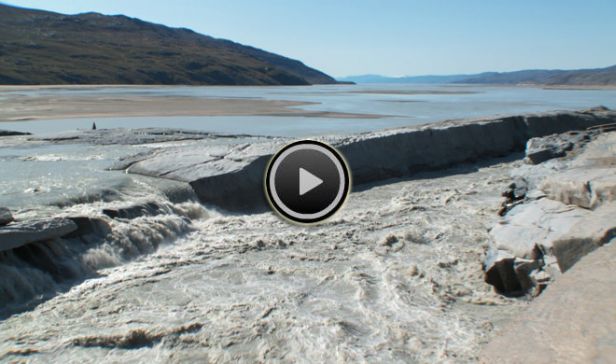Cross-posted from Climate Central.
In many parts of the U.S. March went out like a lion this year.
But a new interactive map of high-resolution climate projections from Climate Central promises much tamer, warmer Marches in the future. In fact, freezing March temperatures will retreat northward this century like a routed army. (The retreat would slow to about half the speed under a low carbon pollution scenario.)
Click on the image above to view the map.
Of course, the idea of thawing temperatures seems pretty nice at the end of a long, snowy winter like the one we just had in parts of the U.S., and the trend does promise earlier starts for golfers, gardeners, and farmers in the future.
But warmer Marches also mean earlier snowmelt — and that’s got some rather different consequences. Across the American West, early snowmelt years have already been linked to drier rivers and forests later in summer and to much higher wildfire activity (see this video on the fire situation in Washington State). Scientists project these problems will worsen with further warming. And water shortages will present challenges for farm irrigation and trouble for trout and other cold-water stream life (explored more in this video about Montana).
Climate Central‘s maps show what will happen to average March temperatures if we continue to emit carbon at today’s high rate. By the end of this century, all states analyzed will experience a majority or near complete loss of areas in which average March temperatures are currently below freezing. The biggest losers, in terms of total area, will be Minnesota, Montana, and North Dakota; but seven states, from Arizona to Wisconsin, are projected to lose just about all their frozen March acreage. (For a full tally, see this table.)
It’s interesting to note that while Washington, D.C. had record-breaking winter snows this year, March temperatures in the nation’s capitol never dipped below freezing — a new record for warmth.
Speaking of warmth, the thaw season has just begun in the Arctic. Over recent decades, the Arctic has been the fastest-warming region on the planet, a pattern scientists expect to continue. Arctic warming trends and their consequences — shown in this new video short (based mainly on NASA satellite data) — make projections of March warming in the U.S. look tame.
Click on the image above to watch the video.
For example, Greenland is shedding ice at a rapid pace; the average net loss per year from 2004 to 2007 was about 25 times greater than the average from 1992-2002. How much of this shift may have come from natural variation and how much from human-caused warming is difficult to assess. But two things are clear: Arctic warming means Greenland ice loss, and Greenland ice loss means rising seas. Recent scientific studies that take Arctic trends into account generally project more than a three-foot rise in sea level this century.
Another key trend just coming to light is that the crust of ice that covers parts of the Arctic Ocean has been getting thinner. Most observers have focused on the shrinking extent of Arctic sea ice. But the ice appears to be thinning even faster. Just-published research (subscription required) suggests that the ice may be thinner than we thought, a troubling finding since thinner ice is more vulnerable to future disintegration.
Bright, white sea ice reflects the sun’s energy back into space — like a giant planetary heat shield. As sea ice disappears, more dark ocean is exposed, absorbing more of the sun’s heat, and accelerating Arctic warming.
So, as we dump our winter coats and turn our minds to spring — let’s take a moment to celebrate the cold days of March, while they’re still with us!




